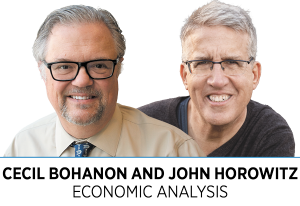Subscriber Benefit
As a subscriber you can listen to articles at work, in the car, or while you work out. Subscribe Now Are we in a recession? We can’t recall a time in our 40-year-plus careers where this has been such a loaded and partisan question.
Are we in a recession? We can’t recall a time in our 40-year-plus careers where this has been such a loaded and partisan question.
Yes, a standard definition of a recession is a decline in inflation-adjusted or real gross domestic product for two quarters. And, yes, it is also true that a period is historically deemed to be a recession when the National Bureau of Economic Research Business Cycle Committee declares it to be so—usually after the fact, using a variety of factors in addition to real GDP changes. This much is certain: The party in the White House will prefer the NBER standard, while the opposition party will prefer the two-quarter standard. Sorting this out is a fool’s errand.
A better question to our mind is, what will happen in the U.S. economy next? A reasonable way of approaching this is to examine what occurred in similar situations in the past. We examine quarterly economic data for the United States from 1960 to 2022 from the Federal Reserve Bank of St. Louis. There were nine periods when real GDP declined for at least two successive quarters or declined in two of three successive quarters. Label these periods downturns. They were as short as two quarters and as long as 10. Label recoveries as ensuing after three successive quarters of increases in real GDP. Also look at inflation and unemployment data during the time frames.
In all cases except one, the inflation rate either stabilized or declined during the downturn. The sole exception was in 1973-1975, when inflation actually rose as real GDP declined. The unemployment rate rose in eight of the nine downturns and continued to rise after recovery in seven of the nine cases. In eight of the nine cases, it took at least two years for the unemployment rate to return to its pre-downturn level, usually much longer. It took until 2019, 50 years, for the economy to experience the 3.6% unemployment rate it enjoyed just before the recession of 1969.
So, what does this bode? We suspect inflation will eventually be conquered. We give even odds as to whether inflation has peaked. The odds of hyper or runaway inflation are minuscule. We expect unemployment to rise, but not radically. This is the strongest labor market in 50 years and the strongest one ever when real GDP is declining. So, it could be worse.
Let’s hope we are right.•
__________
Bohanon and Horowitz are professors of economics at Ball State University. Send comments to [email protected].
Please enable JavaScript to view this content.
